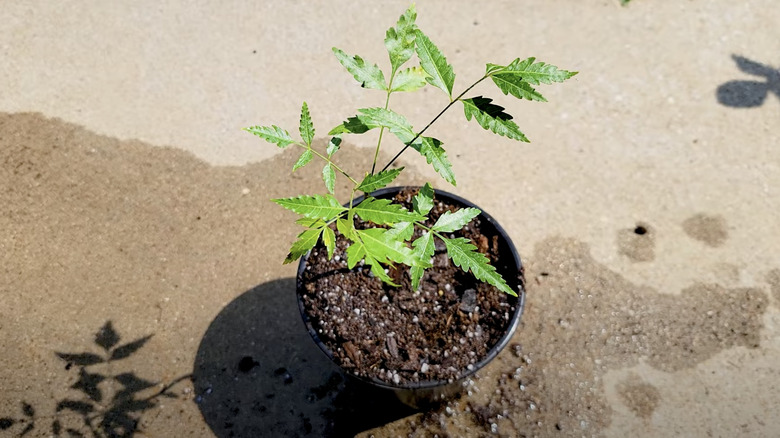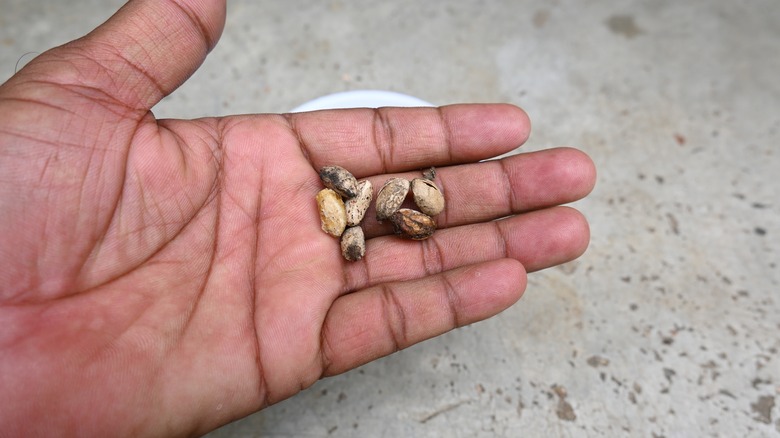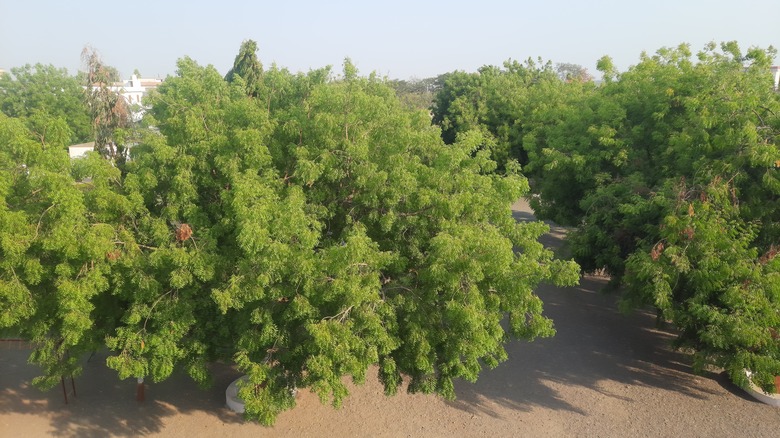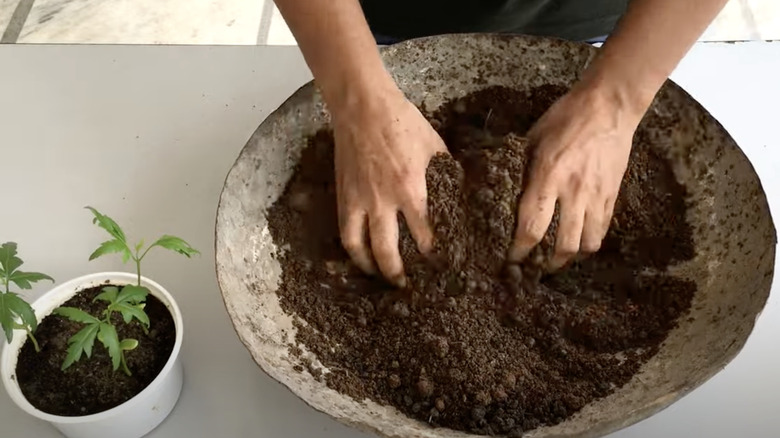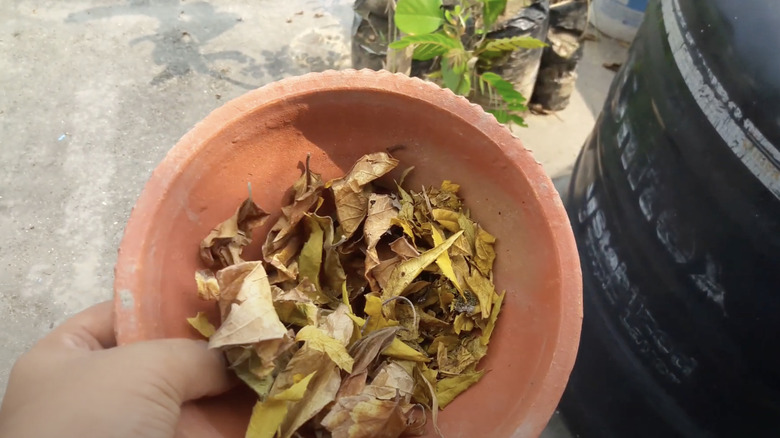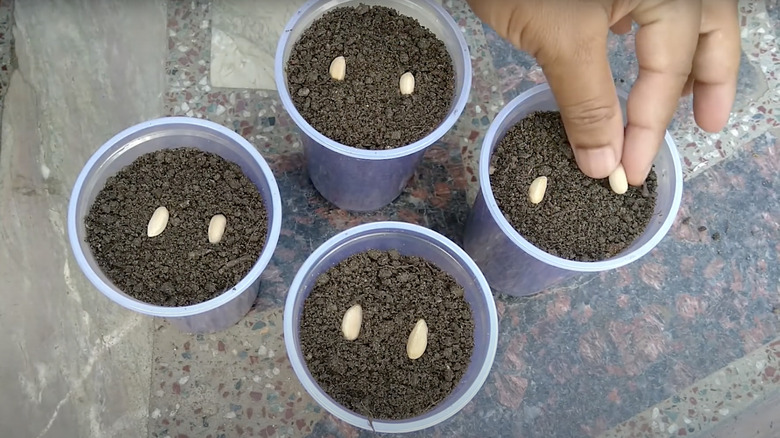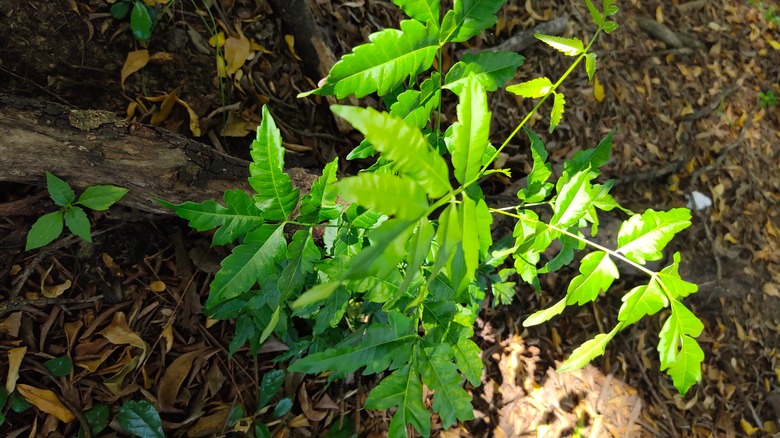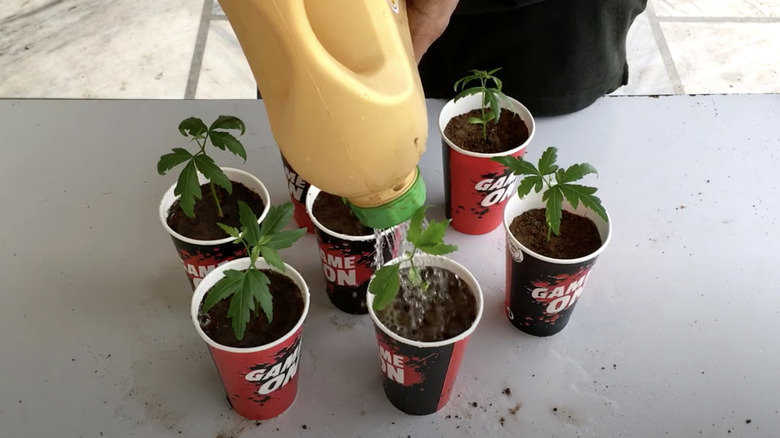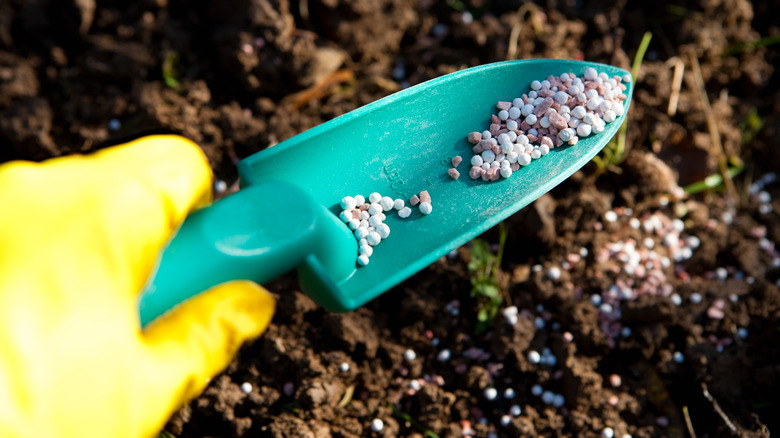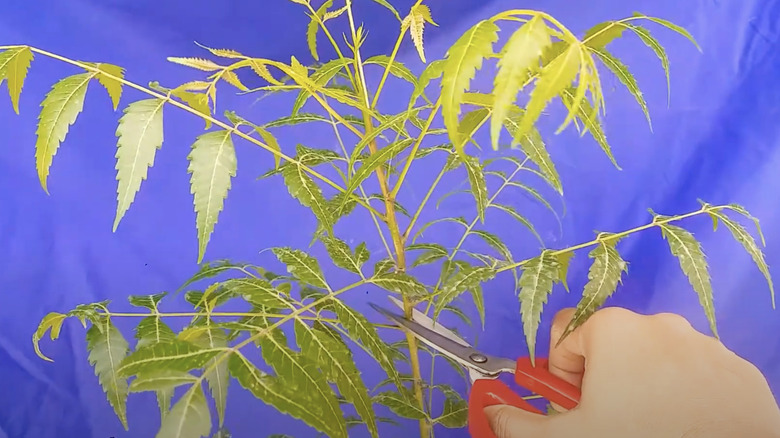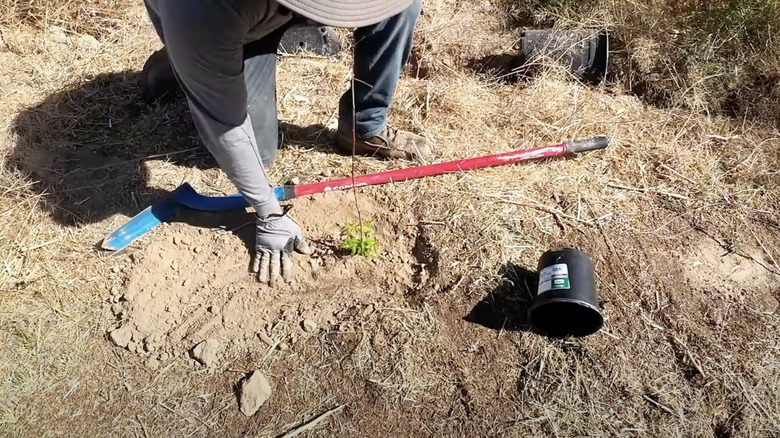Mistakes Everyone Makes When Growing Neem Trees
We may receive a commission on purchases made from links.
Few trees are as beautiful as the neem tree (Azadirachta indica), which sprouts lovely flowers and fruits throughout the year. In addition to its aesthetic qualities, this tree is remarkably resilient in extreme conditions, and its oil is useful for various medicinal purposes. At first glance, it seems like the perfect addition to any landscape or home interior. However, despite their robust nature, neem trees require specific conditions to flourish and need the guidance of a knowledgeable caretaker to thrive outside of their natural environments.
With enough space to grow, neem trees reach 100 feet tall and have branches that spread up to 8 feet across. They also prefer soil and weather conditions that aren't common in the United States, nor popular with the majority of popular indoor and outdoor plants. It's important to know this plant's needs and preferences to avoid the many common mistakes others make when planting a sapling or seeds. Learn more below about common mistakes people make when planting neem trees, so you don't face the same issues during your own gardening journey.
Planting old seed packets
When buying a pack of seeds, most people don't feel a sense of urgency. A majority of outdoor and houseplant species seeds last for three years or more if stored correctly, giving you more than enough time to get around to planting. However, neem trees are fussier than the typical house or garden plant — they reputably aren't viable after two to six months. If they aren't planted with haste, there's little chance of them ever sprouting. It should be said that some species observed in France did last longer, but this doesn't correlate with most reports on neem seeds' planting window (via National Academies Press).
Once you've acquired neem seeds, you should plant them as soon as possible for the highest chance of success. It's a race against a biological timer, and planting within a month of receiving them improves your odds. Place at least two to three seeds per hole to increase the chances that at least one of them will sprout. Remember, you can always avoid the ambiguity of seed viability by planting neem saplings instead.
Growing in cold and wintery locations
Although the neem tree's exact origins are unknown, it is reportedly native to all of the Indian subcontinent. Given its natural environment, this species thrives in tropical and subtropical areas, where temperatures rarely, if ever, drop below freezing. When it comes to rainfall, it thrives in anything from around 17 to 47 inches per year. With this in mind, it's suitable for warm geographical locations, as long as outdoor temperatures are stable. When grown in areas that drop below 40 degrees Fahrenheit for too long, the tree won't make it through its first winter, succumbing to prolonged cold and frost.
Check your local climate before investing in this species, since neem trees can't thrive everywhere in the United States. USDA Zones 9 and 10 are the best bet, and they include Arizona, California, Florida, and Texas. Growing an indoor neem is possible in other areas, so long as the room's humidity is kept around 40% to 50% and the furnace runs throughout the winter.
Using improperly mixed or balanced soil
Aside from climate preferences, neem trees also have certain soil needs. Without the right soil, the plant leaves droop, mold and fungus growth run rampant, and the plant becomes vulnerable to root rot and disease. Neem trees need well-draining soil above all else, making it imperative that you choose a mixture with the correct pH levels and composition.
Wild neem trees reportedly survive harsh, infertile soils, meaning anything rocky or sandy is better than mushy and waterlogged. Ensure the soil mix meets its needs by mixing sand or perlite with the dirt to help aerate it and enable better draining. Aim for a neutral pH level around 6.2 to 7.0, which you can determine using a soil meter ($9.99 on Amazon). If the pH is off, raise it by adding lime to the earth. You can also lower it using soil compounds with aluminum or iron sulfate. Be wary when lowering the pH — it's much more difficult to restore once it's lowered compared to when it's raised.
Not watching for common pests
Neem trees naturally repel pests due to a major compound in their leaves: azadirachtin. Although naturally resilient, they can still fall victim to insect infestations without proper precautionary measures. Scale insects commonly infest this species and others, causing leaves and twigs to yellow, wilt, and eventually die.
The easiest way to identify scale early is by watching for mold growth on plants. Scale usually leaves a blackish mold in its wake, making it easy to identify. Prune the affected branches as soon as possible, bagging and trashing the foliage. Early infections are also treatable by wiping afflicted leaves with rubbing alcohol-soaked cotton swabs. To prevent such infestations in the first place, be careful not to overwater the neem tree and use organic pesticides after every rainfall or watering. Coat younger and smaller trees in a layer of DIY insecticidal soap to stop most insects from establishing a home base. However, insecticidal soap isn't viable as neem trees mature — they get very large, and there's too much surface area to cover.
Not preventing and treating plant diseases during the early stages
Like all plants, neem trees can quickly be overcome with the disease if you miss early symptoms. They're vulnerable to the same diseases that potentially plague all trees: root rot, blight, powdery mildew, and canker disease. The signs of these diseases vary, but generally, you'll notice excessive leaf drop and discoloration.
Avoid diseases by maintaining proper conditions throughout your neem tree's life. Make sure it has the right nutrients, especially zinc and potassium, which promote strong growth. Nutritional deficiencies cause chlorisis, which is diminished color in the leaves that inhibits growth and health overall. This weakens the plant and makes it more vulnerable to the aforementioned diseases.
Even if your neem tree isn't yet infected, isolate healthy plants from those that appear infected. When a neem is still a sapling or in the propagation phase, it's easy to relocate to safety. However, larger trees aren't mobile, so make sure to watch the neem tree itself and any nearby plants for signs of decay, so you can nip the problem in the bud as soon as possible.
Improperly germinating seeds before planting in a pot
"Germinating" is the fancy term for when a seed develops into a sapling, and you need to provide the right conditions for this process to occur. Seeds germinate naturally in the wild, but potted plants must be helped along. If you skip any important steps, no saplings will emerge in the one to three weeks after planting, and the seeds will remain dormant beneath the soil.
Pour neem-appropriate soil mix into each 5-inch deep cup or pot you plan to start your seeds in. Put two or three seeds in each receptacle and put them at least an inch deep in soil. Water them immediately and relocate them to a warm spot. Over the next few weeks, only water when the soil feels dry. If you don't see any growth within a month, the seeds may no longer be viable, and you'll need to try again with a new set.
Placing your plant in direct sunlight too early
Like all plants, trees are most vulnerable and temperamental to outside conditions when young. Neem trees are considered young until around three to five years old. They start bearing fruit at this point, marking that they've reached maturity, though they won't be truly fully grown until the 10-year mark. Given their young and fragile nature, intense sunlight can scorch sapling leaves and slow their growth.
Avoid exposing neems to too much sunlight by keeping them in partial shade provided by taller plants or buildings. It's easier to move your neem tree around if you start it in a pot, so you can relocate it if the sunlight is too harsh. It should be about one to two months before your plant is tall enough (around 11 inches) to flourish in more sunlight. Depending on local factors, you may need to wait even longer before moving it into full sun.
If you're growing your neem indoors, be more concerned about not getting enough sunlight than too much. Place it in a south-facing window to ensure it gets the most sunlight throughout the day. Sun scorch is still possible, but easily solved by occasionally rotating your plant pot so other sides are exposed to natural light.
Overwatering or underwatering throughout the growing season
One of the most common mistakes among amateur gardeners is accidentally overwatering or underwatering plants. Neem trees naturally grow in desert-like environments, so overwatering is usually the problem. When too moist, the soil will feel mushy and wet, even days after watering. Leaves will also lose color and droop.
It's essential you take action as soon as possible. Overwatering causes root rot and other fungus-related diseases to afflict your plant. Start by making sure the neem tree is getting enough sunlight every day and that you're watering in the early morning — the sun dries up excess moisture and helps keep watering under control. Outside trees may flourish from natural rainfall, meaning watering shouldn't be a major priority, however, indoor trees usually must be watered once every ten days.
The exact amount of water depends on the size of your plant and local conditions, and it may take some experimenting to master the exact quantity an individual plant needs. Try using a measuring cup to water your neem so you can carefully monitor how much you're watering each day. This provides more control than eyeballing the quantities, making it easier for you to increase or decrease the amount as needed.
Using incorrect fertilizer or using too much or too little
Plants need nutrition just as people do, and neem trees benefit from a balanced fertilizer. Without the right combination of nitrogen, phosphorous, and potassium, trees have stunted growth and a weak foundation, which doesn't ensure a long or healthy life. It's important that they're nourished in their younger years to ensure they can grow strong and healthy.
Make sure the tree has the resources to grow by using a diluted liquid fertilizer or combination granular fertilizer once a month in the spring and summer. You don't need to fertilize during the winter, since plant growth typically slows around this period. Choose a fertilizer that has an equal ratio of the three major nutrients, which should be marked by three large numbers on the front of the product.
If the tree is in a pot or indoors, liquid fertilizer is fine. However, if the neem is planted outside and directly in the ground, consider using granular fertilizer. Granular fertilizers, which come in slow or controlled-release forms, don't leave toxic buildup on soil and slowly release nutrients over the course of several weeks. This makes them safer for your local environment and other nearby plants and trees that could be harmed by liquid, fast-release fertilizer runoff.
Improperly pruning them too late in life
Pruning isn't just a technique to control growth, it physically shapes how your tree grows throughout its life. Neem trees should be pruned as early as two years old to ensure they grow in an aesthetically pleasing bushy shape. Without proper cutting, they may grow in unwanted directions or have a more scraggly appearance.
Properly prune your tree by first choosing the main stem that will be its trunk. Remove competing branches that could overtake the centermost stem, and prune the rest as needed. Make sure all cuts are at a 45-degree angle and just above the buds. It's vital that you use clean and sharp specialty gardening shears throughout this process. Neglecting to disinfect or sharpen your tools could prove fatal — a dull or dirty blade injures plants and leaves them vulnerable to infection.
Choosing unfit companion plants
Neem trees are known for being super tall, and reach heights of over 50 feet when fully mature. Due to their full-bodied nature and warm and dry climate preferences, they don't make good companions for many houseplants or field crops. They loom over other plants, obscuring the sun and hindering their neighbors' abilities to photosynthesize. This doesn't harm the neem plant itself, but puts other full-sun plants at risk.
It's recommended that neem orchards have 13 by 6.5 feet of open space around each tree. This provides plenty of space for them to grow to their full size without being hindered by nearby structures or other plants. Make sure any companion plants you put alongside them also prefer sandy soil at a neutral pH. The plants should also be okay with partial shade throughout the day, especially if the neem tree grows to be large and full. Some potential companion flowers include daylilies, foxgloves, larkspur, yarrow, and more.
